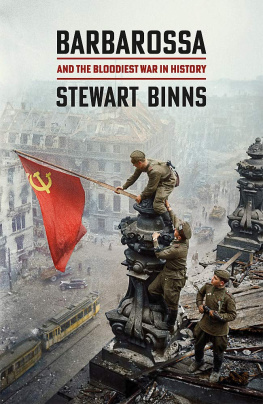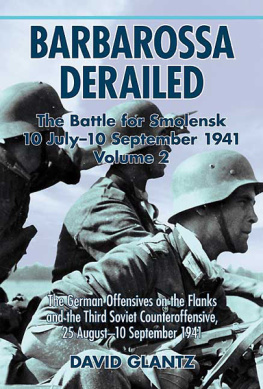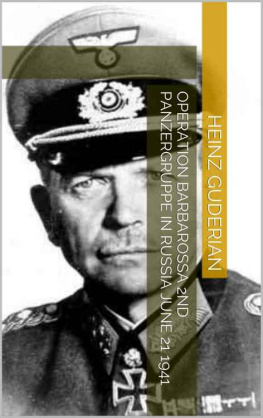Stewart Binns - Barbarossa
Here you can read online Stewart Binns - Barbarossa full text of the book (entire story) in english for free. Download pdf and epub, get meaning, cover and reviews about this ebook. year: 2021, genre: Non-fiction. Description of the work, (preface) as well as reviews are available. Best literature library LitArk.com created for fans of good reading and offers a wide selection of genres:
Romance novel
Science fiction
Adventure
Detective
Science
History
Home and family
Prose
Art
Politics
Computer
Non-fiction
Religion
Business
Children
Humor
Choose a favorite category and find really read worthwhile books. Enjoy immersion in the world of imagination, feel the emotions of the characters or learn something new for yourself, make an fascinating discovery.
- Book:Barbarossa
- Author:
- Genre:
- Year:2021
- Rating:5 / 5
- Favourites:Add to favourites
- Your mark:
- 100
- 1
- 2
- 3
- 4
- 5
Barbarossa: summary, description and annotation
We offer to read an annotation, description, summary or preface (depends on what the author of the book "Barbarossa" wrote himself). If you haven't found the necessary information about the book — write in the comments, we will try to find it.
Barbarossa — read online for free the complete book (whole text) full work
Below is the text of the book, divided by pages. System saving the place of the last page read, allows you to conveniently read the book "Barbarossa" online for free, without having to search again every time where you left off. Put a bookmark, and you can go to the page where you finished reading at any time.
Font size:
Interval:
Bookmark:


Andrew Roberts, author of Churchill: Walking with Destiny
Celia Sandys, granddaughter of Winston Churchill
Alastair Campbell
General Sir Michael Rose
Nick Hewer
| With Joseph Stalin looking over his shoulder, Soviet Foreign Minister, Vyacheslav Molotov, signs the Nazi-Soviet Pact, Moscow, 23 August 1939. (Niday Picture Library / Alamy Stock Photo) |
| The horrific devastation of Barbarossa. Countless villages are destroyed as the Wehrmacht advances into the Soviet Union in the summer and autumn of 1941. (Sueddeutsche Zeitung Photo / Alamy Stock Photo) |
| With men of the German Einsatzgruppe A looking on, an unnamed Lithuanian nationalist uses a club to beat to death his fellow Jewish citizens in Kaunas, Lithuania, June 1941. The identity of the murderer has never been established definitively, or whether he was the infamous Death Dealer of Kaunas. The image is thought to have been captured by Wehrmacht photographer, Wilhelm Gunsilius. It may well be a scene from the notorious Lietkis Garage Massacre. (Bundesarkiv. B 162 Bild-04145) |
| Red Army soldiers captured by the Wehrmacht are burying their dead, Bialystok, Belarus, July 1941. (INTERFOTO / Alamy Stock Photo) |
| The ravine of Babi Yar, Kiev, Ukraine, where 33,771 Jews are murdered in a single operation by Einsatzgruppe C and Ukrainian collaborators, 2930 September 1941. (CPA Media Pte Ltd / Alamy Stock Photo) |
| The execution of partisan HERO of the Soviet Union, Zoya Kosmodemyanskaya, in the village of Petrishchevo, 55 miles west of Moscow, 29 November 1941. Before her execution she was brutally tortured, but never revealed any information. After her death, her body was put on public display and mutilated. (ITAR-TASS News Agency / Alamy Stock Photo) |
| A German victim of the Red Armys General Winter, frozen in the snow, January 1942. (mccool/ Alamy Stock Photo) |
| Burying the dead, the shocking reality of the Siege of Leningrad, the Volkovo Cemetery, 3 February 1942. (ITAR-TASS News Agency / Alamy Stock Photo) |
| A child dead from starvation in the Warsaw Ghetto, Poland. There is no date for the image, but it is likely to have been taken in early 1942. (ITAR-TASS News Agency / Alamy Stock Photo) |
| Red Army riflemen of Colonel General Alexander Rodimtsevs 13th Guards Rifle Division advance through the rubble of Stalingrad, 1618 September 1942. (akg-images / Alamy Stock Photo) |
| Under the cover of Soviet Air Force Ilyushin II-2 ground attack aircraft, T34 tanks advance during the Battle of Kursk, July 1943. (ITAR-TASS News Agency / Alamy Stock Photo) |
| A Red Army nurse helps a wounded soldier at the front. Neither a date nor place are recorded. (dpa picture alliance / Alamy Stock Photo) |
| Citizens of Odessa greet a Red Army cavalryman of General Vasili Chuikovs Eighth Guards Army after the citys liberation, 10 April 1944. (SPUTNIK / Alamy Stock Photo) |
| A Red Army tank commander leans over the barbed wire of a German concentration camp to greet a prisoner. The camp is not named, and the only date given, is April 1945. However, the date suggests that it is Ravensbrck, 56 miles north of Berlin, which was liberated on 30 April. Although the camp was a womens camp, there were a number of male inmates. (akg-images / Alamy Stock Photo) |
Font size:
Interval:
Bookmark:
Similar books «Barbarossa»
Look at similar books to Barbarossa. We have selected literature similar in name and meaning in the hope of providing readers with more options to find new, interesting, not yet read works.
Discussion, reviews of the book Barbarossa and just readers' own opinions. Leave your comments, write what you think about the work, its meaning or the main characters. Specify what exactly you liked and what you didn't like, and why you think so.











